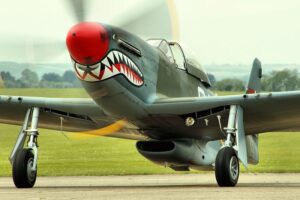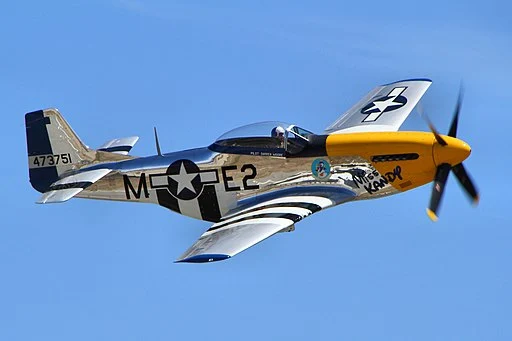Your basket is currently empty!
Introduction
The North American P-51 Mustang is widely considered one of the best fighter aircraft of World War II. Introduced in 1942, it was designed for speed, range, and aerial dominance. What set the Mustang apart wasn’t just its looks or firepower — it was the aircraft’s ability to escort bombers deep into enemy territory and return safely. In the skies over Europe and the Pacific, the P-51 changed the course of the air war.
Development and Origins
Originally developed for the British RAF, the Mustang began as a fast but underpowered plane. That changed when engineers paired it with the powerful Rolls-Royce Merlin engine, giving it performance on par with the German Bf 109 and Fw 190. The U.S. Army Air Forces quickly adopted the improved model — the P-51D became the most iconic version.
Combat Performance
The Mustang excelled in multiple roles: escort missions, ground attacks, dogfights, and reconnaissance. Its long range — over 1,600 miles with drop tanks — allowed it to accompany B-17 and B-24 bombers all the way to Berlin and back. This capability drastically reduced Allied bomber losses and gave the U.S. air superiority in Europe.
Technical Specs
-
Engine: Packard V-1650-7 (license-built Rolls-Royce Merlin)
-
Top Speed: 437 mph (703 km/h)
-
Range: 1,650 miles (2,655 km) with drop tanks
-
Armament: 6 × .50 caliber (12.7 mm) M2 Browning machine guns
-
Role: Fighter / Escort / Ground Attack
Global Use and Legacy
The P-51 wasn’t just a U.S. aircraft — it served in the air forces of Britain, Canada, Australia, New Zealand, and China. After WWII, Mustangs were used in the Korean War and by other countries for decades. Its sleek design, agility, and firepower made it a legend among pilots and aviation enthusiasts alike.
Impact on WWII

Military historians often credit the P-51 with helping to secure victory in the air war over Europe. By 1944, the Mustang had nearly eliminated the Luftwaffe’s dominance. Its presence allowed daytime bombing raids to continue, weakening German industry and morale. General Dwight D. Eisenhower called the Mustang one of the key weapons that won the war.
Where You Can See One Today
Restored P-51 Mustangs can still be seen flying at airshows around the world. Museums like the Smithsonian Air and Space Museum and Imperial War Museum Duxford have Mustangs on display. The aircraft’s distinct roar and iconic silhouette keep the legacy alive even 80+ years later.
Conclusion
The P-51 Mustang wasn’t just a fighter — it was a game-changer. Fast, reliable, and deadly, it earned its place as one of the most effective aircraft in aviation history. From escort missions over Europe to dogfights in the Pacific, the Mustang remains a symbol of American air power and engineering excellence.
Explore more historical war machines on our War Machines site.

